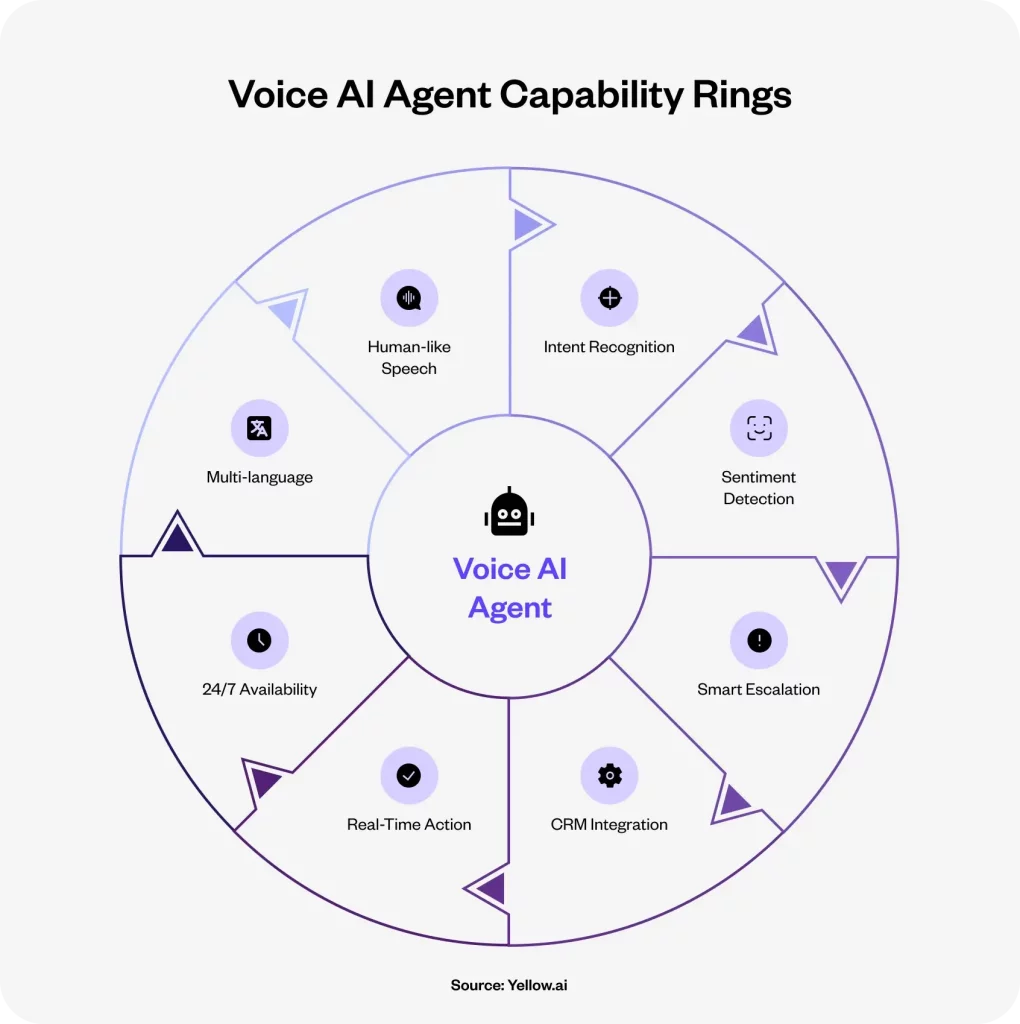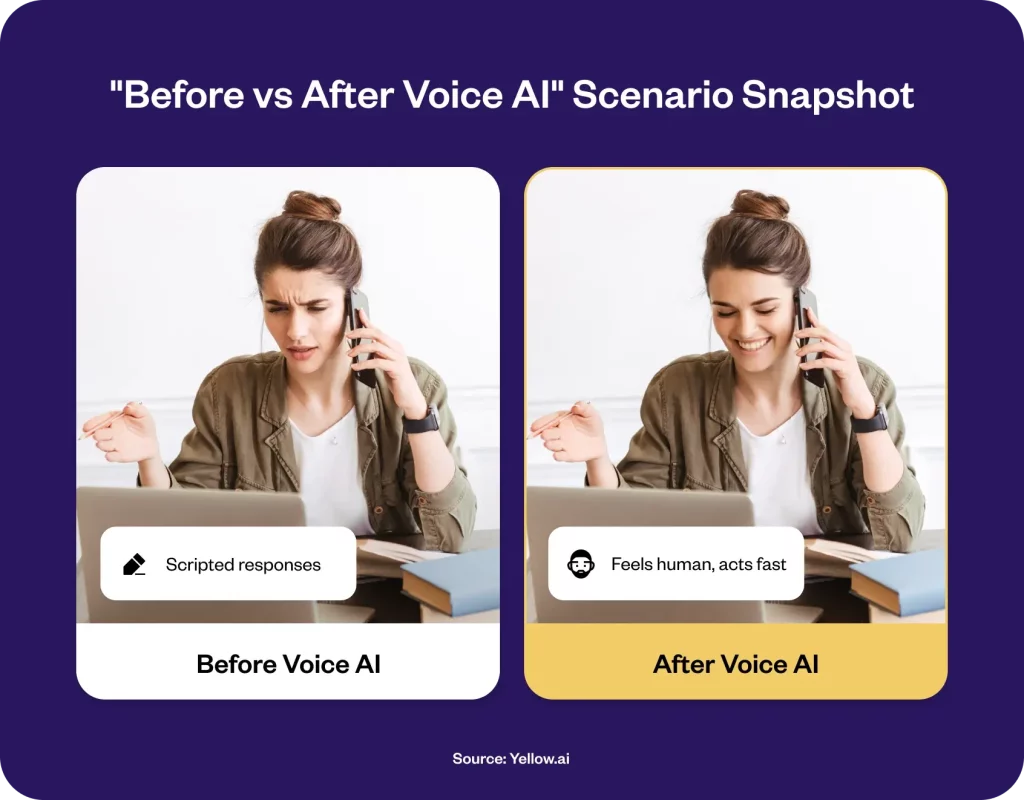Why Enterprises Are Moving From Voice Bots and Traditional IVRs to Voice AI Agents
Every other research on customer experience and service tells the same brutal story: majority of (61%) customers will take their business elsewhere after one frustrating phone support experience. Yet most enterprises are still forcing callers through friction-filled phone trees, complete with endless hold music and robotic “press 1 for…” menus that would make a 1990s answering machine blush.
The enterprises thriving in 2025 have cracked a different code entirely. They’ve discovered that implementing voice AI agents in their contact centers isn’t about replacing humans with robots; it’s about turning every customer interaction into a competitive weapon. Instead of automating for the sake of automating, the value is in bringing in relevant and effective AI solutions which deliver conversations that not only resolve the customers’ queries but actually feel… conversational.
What’s more, the capability gap between voice AI leaders and laggards is widening exponentially, creating what economists call a “winner-take-most” market dynamic that’s reshaping entire industries.
This blog explores why voice AI agents are becoming essential for enterprise customer experience and how to deploy them strategically.
What are Voice AI Agents?
Voice AI Agents are intelligent and efficient virtual agents that use the natural language processing (NLP), intent recognition and conversational AI to understand and resolve customer issues over the phone without having to rely on static, rule-based scripts. Unlike traditional IVRs, these agents can handle open-ended inputs, adapt based on sentiment, and take actions autonomously. Think of them as your smartest frontline agent, but available 24/7, across 100+ languages, and capable of resolving issues without waiting on hold or consulting a script.
Voice AI agents are especially critical in enterprise settings where scalability, multilingual support, and integration with backend systems are required to deliver seamless, human-like automation.
From Scripted Responses to Autonomous Support: The Evolution of Voice Automation
Voice automation has evolved from rigid, menu-based systems to intelligent, responsive agents that adapt in real time. This shift marks a critical turning point in how enterprises approach customer service at scale.
IVRs vs Voice Bots vs Voice AI Agents At A Glance
Not all Voice Automation are created equally, Here’s how legacy systems compare to Voice AI agents:
| Feature | IVR | Voice Bot | Voice AI Agent |
|---|---|---|---|
| Input Style | DTMF (keypad input) | Keyword-based | Natural Language |
| Flexibility | Fixed menu flows | Rule-based scripts | Dynamic, context-aware |
| Learning Ability | None | Limited | Self-learning through AI |
| Autonomy | Manual routing | Basic commands | Goal-driven with Agentic AI |
| Use Cases | Basic routing | FAQs | End-to-end task resolution |

Key Capabilities of Enterprise Voice AI Agents
- Real-time Intent Recognition
Modern Voice AI Agents understand, listen and interpret natural, open-ended speech to detect the caller’s intent in real time. This enables them to deliver faster, more accurate responses without relying on scripted flows. It eliminates the need for rigid menus and improves resolution speed.
- Sentiment-Aware Escalation
Advanced sentiment analysis allows Voice AI Agents to pick up on frustration, urgency, or confusion in the customer’s tone or language.Modern agents now analyze vocal biomarkers including pitch, tone, and speech speed to detect emotional states in real-time, going beyond text-based sentiment to understand the caller’s emotional context. When emotions spike or confidence drops, the agent can trigger smart handovers to human representatives, preserving context and avoiding escalation fatigue. This reduces friction, and improves CSAT.
- CRM, Helpdesk & Knowledge System Integration
Voice AI syncs with Salesforce, Zendesk, and other platforms, integrating real-time data streams and behavioral insights to deliver hyper-personalized conversations. This allows them to pull relevant information on the fly, personalize conversations, and log interaction data automatically, creating a continuous feedback loop for service improvement.
- Proactive Conversation Management
Voice AI Agents are evolving from reactive responders to proactive assistants that anticipate user needs based on conversation patterns, historical data, and contextual cues. This enables them to offer solutions before customers explicitly ask, improving resolution speed and satisfaction.
- Agentic AI-Driven Autonomy for Outcome-Focused Conversations
Unlike basic bots, Voice AI Agents operate under Agentic AI principles: they don’t just follow instructions, they pursue defined goals within business-approved guardrails. Whether it’s resolving a billing query, processing a cancellation, or rebooking a service, the agent adapts to the situation and makes decisions in real time, reducing the need for manual intervention.
Emerging Voice AI Technologies in 2025
Voice AI is advancing rapidly in 2025, introducing breakthrough capabilities that enable more sophisticated, human-like enterprise conversations beyond traditional automation.
Emotional Context Processing
As mentioned above, voice agents now analyze vocal biomarkers including pitch variations, tone shifts, and speech pace to detect emotional states in real-time. This enables automatic routing of distressed customers, dynamic tone adjustment, and preemptive escalation of critical situations.
Multi-modal Conversation Integration
Voice interactions seamlessly blend with visual and text interfaces, creating unified omnichannel experiences. Customers can start conversations via voice and continue across web chat, mobile apps, or smart displays without losing context or repeating information.
Adaptive Real-time Learning
Voice agents continuously optimize responses and conversation strategies based on real-time performance feedback. Unlike static systems, these AI agents learn from each interaction, automatically improving their effectiveness without human intervention.
Predictive Conversation Intelligence
Advanced AI service automation platforms analyze conversation patterns and customer history to anticipate needs before they’re stated. These voice AI agents can proactively offer relevant solutions and address potential concerns based on contextual analysis of the ongoing interaction and resolve queries faster, while improving CSAT.
Why Voice AI Agents Matter More Than Ever
Changing Customer Expectations
The majority of consumers now expect a service experience that doesn’t require them to repeat information across channels. Personalization and emotional intelligence aren’t value-adds, they’re the baseline. Failing here costs customers.
Operational Impact for Enterprise CX
- Simultaneously manage thousands of voice conversations
- Reduce average handle time without compromising on empathy
- Deliver 24/7 support with consistent tone and accuracy
Business Value for CX Leaders
Voice AI Agents enable enterprises to deliver faster, more personalized, and context-aware customer interactions, leading to measurable improvements in customer satisfaction and loyalty. Their ability to operate consistently across touchpoints and languages makes them a powerful tool for global-scale support.
Here’s how Voice AI drives business value for CX leaders:
- Higher CSAT and NPS: Faster response times and relevant resolutions reduce friction and increase satisfaction.
- Consistent brand tone: Voice agents maintain your enterprise voice across all interactions, reinforcing brand credibility.
- Improved customer retention: By eliminating hold times and avoiding repetitive inputs, Voice AI helps reduce frustration and churn.
- Omnichannel, multilingual scale: Supports seamless handoffs and interactions across voice, chat, and messaging in over 100 languages
Real-World Use Cases for Voice AI Agents in Customer Service
1. Inbound Support Deflection
Resolve high-volume queries like order status or return policies before they reach human agents, cutting queue times and improving efficiency.
2. Voice-Led Collections & Renewals
Proactively engage customers with payment reminders or renewal prompts through dynamic, two-way voice calls.
3. Appointment Scheduling & Confirmations
AI agents handle bookings, reminders, and reschedules via voice, syncing with calendars and reducing no-shows.
4. Smart Escalations to Human Agents
Automatically route complex or sensitive calls to live agents, with context, using sentiment and intent detection.

Voice AI Business Impact for Enterprises
1. Reduce costs without cutting corners
Voice AI Agents unlock true scale without increasing headcount. By automating high-volume, low-complexity calls, such as order tracking, appointment scheduling, and basic troubleshooting, enterprises typically see a major reduction in live agent workload.
That means your support teams can focus on high-value, complex issues, while your AI agents handle the rest, 24/7, without breaks, delays, or inconsistencies. The result being? Lower operational costs and a higher ROI on your CX stack.
2. Elevate CX across the board
Customers today expect fast, and human-like service, especially over voice. Voice AI Agents deliver just that by understanding open-ended speech, detecting sentiment, and taking action in real time.
They don’t just respond, they adapt to the customer’s tone, urgency, and context, ensuring that each interaction feels natural and personalized. Smart routing, proactive assistance, and contextual memory all contribute to a more satisfying and emotionally intelligent customer experience.
3. Actionable Insights from Every Interaction
Voice AI doesn’t just automate conversations, it captures and analyzes them. Every interaction becomes a data point for continuous improvement. Platforms like Yellow.ai Analyze track containment rate, sentiment shift, resolution quality, and escalation frequency in real time, helping CX leaders pinpoint where the experience breaks, and fix it fast.
These closed-loop insights don’t just improve AI performance, they enhance agent training, optimize workflows, and uncover customer pain points at scale.
Voice AI Implementation: Best Practices for Enterprise Deployment
1. Start with high-volume, low-complexity use cases
Begin with service areas like order tracking, account FAQs, or appointment reminders. These are repeatable, well-defined workflows that allow Voice AI Agents to deliver immediate value without disrupting core operations.
2. Use real-time performance dashboards
Track metrics like containment rate, escalation frequency, and customer effort score through centralized dashboards. This helps identify friction points early and fine-tune both automation logic and escalation rules with precision.
3. Align with internal teams and service architecture
Voice automation should not operate in isolation. Work closely with IT, customer support, and product teams to ensure voice flows align with existing escalation protocols, data systems (like CRMs), and brand tone.
4. Design responsible escalation paths
AI handoffs must feel smooth instead of a restart. Ensure your agents can escalate to human agents with full interaction history and context, minimizing frustration and improving resolution quality.
Choosing the Right Voice AI Platform: 5 Must-Haves
Not all Voice AI platforms are enterprise-ready, and choosing the wrong one can stall transformation before it starts. As you evaluate vendors, look beyond surface-level features and assess whether the platform can deliver scalable, secure, and intelligent automation across your support ecosystem.
Here are five must-have capabilities that set leading platforms apart:
- Agentic AI Architecture – Look for platforms that don’t just follow rules, instead pursue goals. Agentic AI enables virtual agents to make autonomous decisions within business-defined boundaries, allowing for more flexible, outcome-driven interactions without losing control.
- Real-Time Language Processing – The platform should support free-form, open-ended speech, across diverse accents, dialects, and colloquialisms, without breaking down or misinterpreting intent. This ensures smoother experiences and broader accessibility, especially in multilingual regions
- Integration-Ready – Effortless integration with your existing tech stack – CRMs, helpdesk tools, telephony systems, APIs, is non-negotiable. The right Voice AI should act as an intelligence layer on top of your current workflows, not require a complete overhaul.
- Compliance & Security – Ensure the platform adheres to GDPR, HIPAA, ISO, and relevant regional standards. This includes secure data handling, consent tracking, and audit trails, critical for regulated industries like finance, healthcare, and public sector
- Transparent Escalation Paths – When automation reaches its limits, a smooth transition to human agents is essential. Platforms must preserve full interaction context during escalation to avoid customer frustration and enable faster resolution.
How Yellow.ai Enables Enterprise-Grade Voice AI
Yellow.ai’s VoiceX solves the core problems that plague enterprise voice automation: rigid navigation, poor conversation quality, and lack of emotional intelligence.
VoiceX Core Differentiators:
- SmoothTalk AI: Eliminates interruptions and awkward pauses through intelligent turn-taking. Waits for users to complete thoughts, responds at the right moment for natural conversations.
- Sentiment AI: Real-time emotion detection (frustration, satisfaction, urgency) enables proactive escalation and personalized responses that prevent customer churn.
- Acknowledgement AI: Natural conversational cues (“hmm,” “got it,” “okay”) create human-like dialogue rhythm, making interactions feel genuine rather than robotic.
- Voice Intelligence Architecture: Multi-LLM powered system with seamless interruptibility, real-time streaming, and ~0% hallucinations across 135+ languages.
Enterprise Infrastructure:
- 150+ plug-and-play integrations (Twilio, Avaya, Genesys)
- Omnichannel context preservation across voice, chat, email
- Enterprise security: ISO, HIPAA, SOC 2, GDPR compliance
- 90% automation achieved in 30 days

Conclusion: The Leaders are using Voice AI as a Revenue Engine
The secret sauce of successful voice AI adoption isn’t zeroing in on the best and most cutting-edge tech provider of the month; it’s the mindset shift in how you think about value and ROI in the context of AI versus traditional automation models.
Most enterprises are still trapped in cost-center thinking, asking “How can we handle more calls cheaper?” when the real question is “How can we turn every voice interaction into a relationship-building moment?” This fundamental misunderstanding explains why some companies see voice AI as an expense to minimize costs while others leverage it as a revenue multiplier across functions.
The most effective enterprise implementations are those that measure success not just in cost savings, but in customer lifetime value, retention rates, and the ability to scale personalized service across global markets without losing the human touch.
In the end, customers won’t remember which company had the fanciest voice AI, they’ll remember which one made them feel heard, valued their time, and came to their rescue when they needed it.
FAQs About Voice AI Agents
What’s the difference between a voice bot and a Voice AI Agent?
Voice bots follow rules; Voice AI Agents adapt dynamically using AI, NLP, and real-time data.
Can Voice AI Agents handle multilingual calls?
Yes. Platforms like Yellow.ai support 135+ languages and dialects with native understanding.
How secure is a Voice AI solution for BFSI or healthcare?
Leading solutions are HIPAA- and GDPR-compliant with enterprise-grade encryption and access controls.
How does Voice AI differ from IVR?
IVRs use keypad inputs and static flows. Voice AI understands natural language, detects emotion, and adapts conversations in real time.
Can Voice AI reduce call center costs?
Yes. By deflecting routine calls and improving first-call resolution, Voice AI can reduce support costs by up to 60%.
What industries benefit most from Voice AI?
BFSI, retail, telecom, logistics, and healthcare all benefit from Voice AI’s scalability and multilingual automation.
Voice AI vs chatbots – Which one is better for customer service?
Both serve unique roles. Voice AI is best for real-time, urgent, or low-friction tasks via phone. Chatbots excel in async, digital-first channels like web or WhatsApp.
What makes enterprise AI voice agents different from chatbots or voicebots?
Enterprise AI voice agents use advanced natural language processing and agentic AI to pursue business goals autonomously, unlike chatbots that follow scripted responses. They integrate deeply with CRM and enterprise systems, autonomously handle complex multi-step conversations, detect emotions in real-time, and make decisions within business guardrails.
















